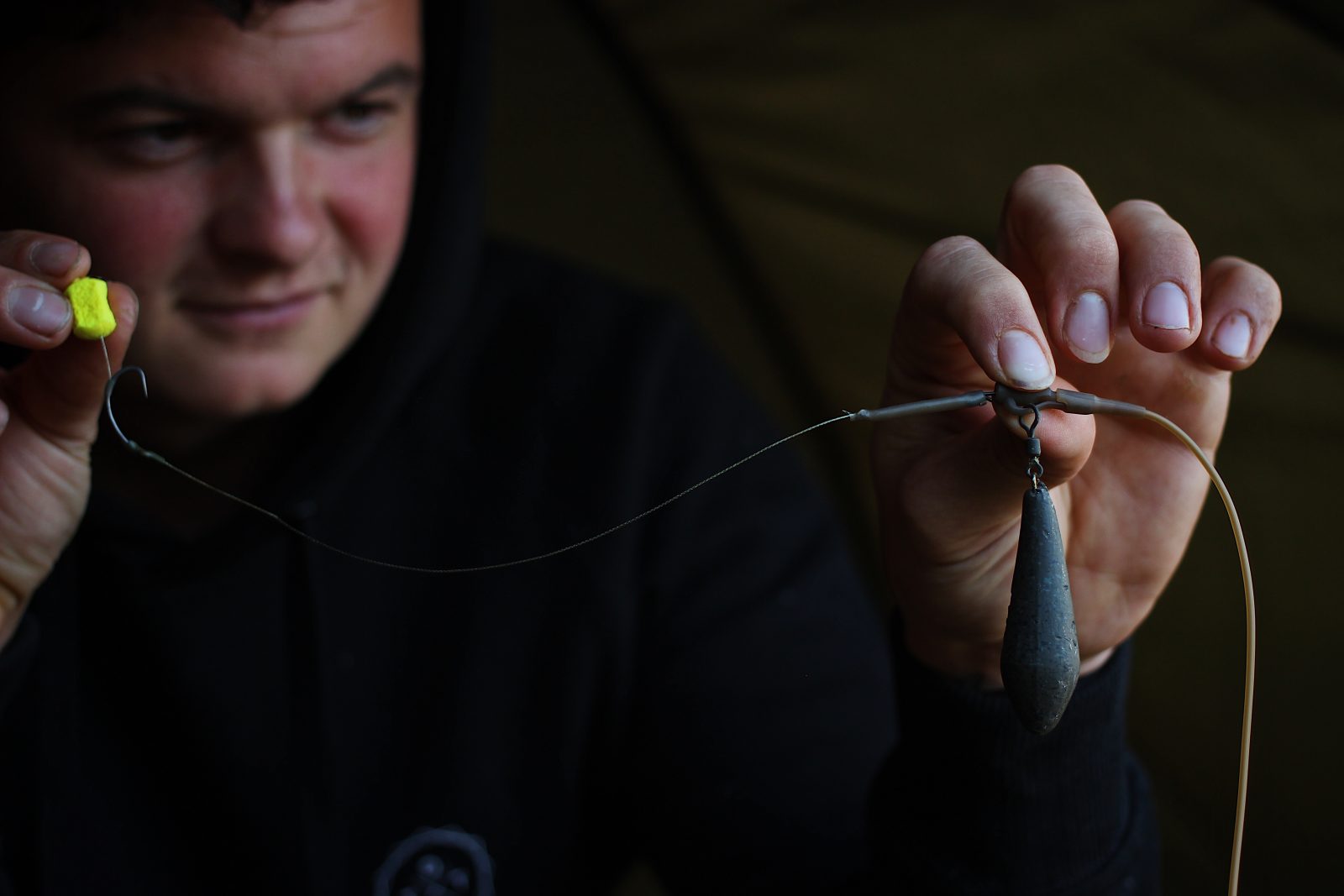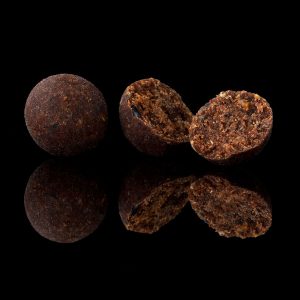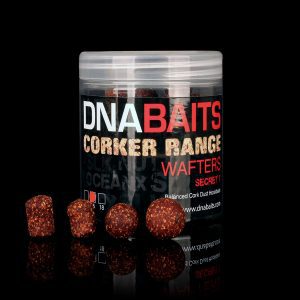
The Single Life
Kent-based carper Olly Sanders reveals his thoughts on single-hookbait fishing, explaining when to go bright and when not!
When the autumn feeding spell draws to a close and the water temperatures begin to drop, our beloved carp behaviour begins to change, most noticeably their feeding habits. They begin to expand less energy in their day-to-day life and require less and less food as a consequence, making them even more difficult to catch. However, with enough observation and thought, there is no reason why regular bites through the colder months cannot be achieved.

A common sight on a winter’s morning
The single-hookbait approach has been a big favourite of many anglers over the years, particularly in the winter months. When the temperature gets colder, the carp’s metabolism will decrease, meaning they are much less likely to feed heavily and consume copious amounts of bait. However, a bright, high-attract hookbait will grab any fish’s attention and will often be just enough to tempt a bite, even when they have no desire to feed. It is a method that can be just as effective on a crystal-clear gravel pit as on a small, chocolate-coloured farm pond; it just needs to be executed correctly.
Over the past 10 years or so, my angling has been heavily dominated by day-ticket waters, some of which I return to regularly and others I may only visit once, but regardless of the water, I have always found single hookbaits the most effective way of getting a bite in the winter. The only thing I may change is the rig or the hookbait, depending on the water I’m fishing, to maximise my chances of getting a bite.
Planning and preparation for a session is absolutely vital, in my opinion. Fail to prepare or prepare to fail, as they say. So, my planning for any trip always begins exactly the same way and that is research! The usual information an angler would search for is generally how the lake is fishing, which areas have the fish been coming from, and what bait the anglers are using? However, I like to push my research that little bit further and think outside the box. The following factors play a big part in my angling mindset and help determine my approach to fishing various waters. The first thing I look at is the stock of fish within a water. There is nothing worse than enduring a really tough weekend blank only to discover at a later the water only holds a small amount of carp. To maximise my chances of a bite, I stick to venues with a relatively larger number of fish, as when in winter, it’s more about putting any fish on the bank, rather than chasing the big girls.
Another factor I will always research is the age of the lake and its stock. This may seem like strange things to consider, but I have found them to important factors over the past few years. Many day ticket venues tend to be stocked with relatively young carp that can be inquisitive in their behaviour. To benefit from the characteristic the best I can, I generally choose to fish with a very bright pop-up. On previous sessions, I have observed these young carp on marginal spots and their reaction to various bait, rigs and hookbaits. Almost every time I have used a bright pop-up on the spot, a carp has changed its course of direction to head straight for the fluorescent colour, nailing itself instantly without any hesitation. After these countless experiences of fishing waters with younger fish, it has become clear to me that taking full advantage of their inquisitive nature can be hugely beneficial, particularly in winter, when they aren’t feeding heavily.

One of my favoured presentations for young day-ticket carp – simple but effective

A douse of DNA Intense Booster is a great way to give your hookbaits some extra pimpage
I remember when I first began putting this into practice a number of years ago on a small water in the south of Kent. The lake itself is around two acres in size and holds a good stock of large, young carp. During an overnight session, I had been informed the lake hadn’t produced a bite for a couple of weeks, which was hardly a surprise when I discovered the lake was partly frozen over. The only thawed area of water was very murky, so I figured a standard bottom bait would easily be missed by the carp, especially as I knew they would be sticking to one area and not moving particularly far. With all of this considered, I went for the most brightly coloured hookbaits I had in my rucksack. Not feeling very hopeful, I used three different-coloured pop-ups over the area I was fishing and went straight to bed. After an uneventful and extremely cold night, I was packing away the last few bits before reeling in when my left-hand rod went into meltdown. It scared the life out of me! Grabbing the rod, I entered an aggressive battle and the fish continued to dart under the ice in an attempt to lose the rig. A short while later, the battle was won and a beautiful 31lb dark mirror was held up for its photoshoot, the bright colour and flavour of a Pink Peril pop-up being too much for it to resist. Since this experience, I have continued fishing this venue over numerous winters and have always had great success using this approach.

A young 31lb mirror that found a Pink Peril pop-up in clouded water

A perfect presentation for a hi-viz single-hookbait approach
I remember another bitterly cold social with some great friends of mine at a venue called Loggies Lake near Canterbury, somewhere I hadn’t visited before. Due to arriving the morning after everyone else, I had to make do with the only available swim, a small bay tucked away in the south-east corner of
the lake. I knew I had to think of something other than searching for the carp, as this was definitely going to be a challenge. However, I had done my research and knew this water was dug in 2004 and was stocked with a good head of carp, with plenty over the 30lb mark. After a handful of casts with a light lead, it was easy to identify the lakebed in front of me had a small layer of blanket weed. With everything considered, I proceeded to fish with a similar approach as before. I used naked chod set-ups baited with three different colours, Pink Perils, Milky Malts and PBs, and cast them over the wide entrance of the bay. When my rods were set and ready to go, one of my friends who was fishing a few swims to my right wandered down for a chat. He had been fishing Loggies throughout the summer and had previously managed to catch some of larger residents of the lake. He had found from his experience that using large beds of bait worked well in his favour. He proceeded to tell me that pop-ups don’t tend to bring any success on the lake and all of his previous catches had fallen to bottom-bait presentations. After a chat over a brew, he went back to his swim while I continued to set up camp. Not a moment later, my right-hand rod screamed into life as one of the residents bolted off into the open water. I eventually managed to coax the fish back towards me after it took approximately 80 yards of line off me! By the time it was plodding around the bay, the entire group had gathered behind me, as this was the first bite since their arrival the night before. After a few heart-stopping moments under the rod tip, a thick-set golden common rolled over the net cord. “YES!” We high-fived one another as everyone took a sneaky peak at my prize in the folds of the net. The fighting carp spun the Reubens around to 33lb 4oz – what a result! Only a few hours after arriving at a water I’d never been to before, landing a thirty was an amazing feeling, made even better by having a group of friends around me to share it with.

My first Loggies carp of 33lb 4oz, another victim of a hi-viz single hookbait
There are many anglers out there who have had similar successes with the single hookbait approach and the majority of them will be dominated by a brightly coloured hookbait. While there have been many instances that have proven well for me, there have also been occasions when I have witnessed the complete opposite behaviour. A mere glimpse of a fluorescent colour can spook some fish, behaviour that common in waters with gin-clear water and where the carp are older and far wiser than their younger, energetic peers. A carp could have spent years being caught after feeding off something bright and exciting and eventually they learn to eat these fluorescent baits less and less. This theory may not apply to the entire older generation of carp, but I have found tweaking my approach to target wiser fish has worked in my favour. I’ve witnessed fish shy away from a bright hookbait, but once changed to something more subtle, the same fish has returned to the same spot and happily picked up the rig.

My number one hookbait and rig: these two together have accounted for an enormous amount of my captures
Towards the end of last winter, I had a 24-hour session on the Mets Lake on the Thorney Weir complex, north of Heathrow Airport. I had previously fished Thorney Weir, but have never ventured on to the Mets, nor did I know anything about the water. I ended up heading to the complex after a failed attempt at another lake, so went into the session completely blind (preparing to fail right there!).
I arrived on the Friday afternoon surprised to find only a handful of other anglers on the lake. I later discovered this was due to the lake’s reputation of being a difficult water – challenge accepted! With so many swims to choose from, it was quite easy to set up near the fish. I found a few held up in an out-of-bounds area behind an island. I jumped in the swim just to the left, giving me the perfect angle to fish the entrance of this area. While I set up my gear, a regular angler wandered past and I began to pick his brains on the venue. He showed me a few fish from his album (they were all old, dark creatures) and told me about their history and how long some of them had been in the lake. A bit star struck at the thought of catching one of these beauties, I began deploying my single-hookbait approach once again. Considering the age of the larger originals in the lake, I proceeded to fish with two rods up tight to the out-of-bounds rope, the first rod armed with a white Milky Malt pop-up on a hinged rig and the second with a DNA Baits Secret 7 barrel wafter. The S7 barrel wafters are my absolute favourite choice of hookbaits at the moment. The S7 name speaks for itself, both during the warmer months and the winter, and I like the deep-red colouring. The wafter was mounted on to a blowback presentation comprising of around 10 inches of Camotex Semi Stiff coated braid, a size 6 medium curve hook and a small piece of hook silicone to create a blow-back effect. I also like to add a small amount of shrink tubing over the eye of the hook to aid the hooking potential of the rig.
Both rods remained motionless that night, but my sleep was regularly disturbed by the sound of carp launching themselves out of the water in the same area. The next morning seemed spot on for a bite and with a low mist drifting across the flat-calm surface I was feeling very hopeful. As the mist began to clear, the right-hand alarm let out a single bleep. I sat there hovering over my set-up willing it to rip off. Trying to remember which rig was on that rod, the tip buckled round as the fish desperately tried to seek refuge back under the nearby rope. Hitting and holding the best I could, the fish’s attempts to reach the rope were thwarted and it came in relatively easily and few moments later, a broad, dark mirror kissed the spreader block. I peered into the net to be greeted by the most amazing carp I had caught in a long time. It was a big ’un too! I saw the dark S7 barrel wafter floating around its mouth and the hook nailed in her bottom lip. At 34lb 4oz, I couldn’t have asked for a better way to open my account on a new water. After a couple of self-takes, she was safely returned to the water. The chap I spoke to the previous evening wandered past again and I couldn’t wait to show him what I had caught. Without hesitation, he exclaimed: “You realise that’s one of the originals, don’t you?” Well, if there wasn’t icing on the cake already, there sure well was after that!

Revolver at 34lb 4oz, a Mets Lake original
I am convinced that had I not adapted the approach I did, based on these factors, I would have had completely different outcomes in all three experiences. Thinking back to my session on the Mets Lake, there was a bright white pop-up close to the wafter, yet the fish went for something subtle that blended into her surroundings. It could have been a coincidence, but I genuinely believe brightest isn’t always best when it comes to old, wise carp.


A couple of recent victims of a more subtle hookbait approach
My angling journey has recently taken me to a few older waters containing some beautiful old carp and the same research and considerations have resulted in some extremely memorable captures. Single-hookbait fishing is rewarding and can be prolific, but planning and preparation before the session could he the things that make the difference. Get it right and you’ll be rewarded in more ways than one. I wish you all the best of luck with your angling this winter.

Winter is tough, but you can still get results with a bit of forward planning and preparation





